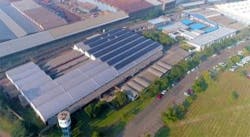Microgrid projects could play a major role bolstering the electric grid in Africa, which needs roughly $1 trillion in investments, according to a white paper by researchers at Boston University.
The power system in sub-Saharan Africa is generally poorly developed and its quality ranges widely from country to country, and even within countries, the researchers said in their paper, “Bringing Power and Progress to Africa in a Financially and Environmentally Sustainable Manner.”
About 600 million people out of Africa’s 1.3 billion population lack electricity, according to the report.
Africa’s weak transmission system, especially between countries, presents a major barrier to large, centralized power projects, the researchers said.
“This fact drives African electricity sector development towards a greater reliance on generation additions in smaller increments — which in turn provides additional impetus for the deployment of solar and wind projects that are already benefiting from declining cost trends,” the researchers said. “The advancement of energy storage technologies will also support an increasing trend towards distributed renewable energy generation assets.”
Mega grids likely to decline in importance
Although Africa’s power sector is ripe for investment, project finance in the continent is risky given poor revenue streams in the electricity sector and country risks, according to the Boston University researchers.
Large-scale electricity infrastructure projects — power plants larger than 100 MW and long-distance transmission lines — will increasingly be deemed too risky for the returns that they can offer, the researchers said.
However, distributed energy resource-based, small-grids with smaller capital requirements will increasingly be recognized as superior return prospects for their risk profile, according to the report.
“This will cause mega-project development in Africa to proportionally decline in importance (except those with compelling renewable resources that support an existing operationally-serviceable urban grid) and off-grid DER-based development to accelerate (especially to enable energy access in rural areas, which characterize the vast majority of the African geography),” the researchers said.
Minigrids connecting several nearby villages and microgrids are likely the least expensive way to bring electricity to rural areas, the researchers said.
Grid of grids possible
Africa’s urban and rural areas have different electricity needs, which will likely shape future grid development, according to the report.
“The latter will leverage the existing grid to the extent possible via refurbishments and targeted investments, while the former can take advantage of the emergence of novel distributed energy resources technologies and business models to deploy entirely new microgrids that have lower capital requirements — and thus the prospect of lower risks to investors,” the researchers said.
Eventually, rural microgrid projects and redeveloped urban grids could merge into a “grid of grids” spreading out across the African continent from initial clusters, the researchers said.
Strong prospects for solar in Africa
Eaton production facility in Wadeville, South Africa. Photo courtesy of Eaton
Generally, Africa has strong solar and wind potential, according to the report. There was 5,500 MW of wind and 4,500 MW of solar capacity on the continent in 2018, according to the report.
“Common everywhere will be an increasing reliance on renewable electricity generation, both centralized and distributed, because of continuing improvements in their economics,” the Boston University researchers said.
Solar will gain the most, but significant amounts of wind will also be built while energy storage will grow along with the intermittent renewable resources, according to the report.
Track news about microgrid projects in Africa. Subscribe to the free Microgrid Knowledge newsletter.









